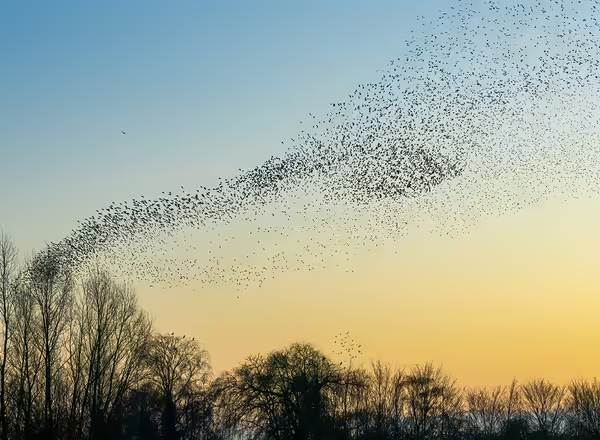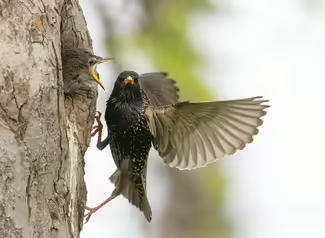
European Starlings
European starlings (Sturnis vulgaris) were introduced to the U.S. in the 1800s and are now naturalized. They compete with native birds for nesting cavities and as large flocks they can cause widespread crop damage.

Generally, starlings impact native bird species through competition for nesting cavities. However, there is little evidence of any serious ecological effect on native avifauna. Starlings appear to outcompete the sapsucker (Sphyrapicus) group of woodpeckers for tree cavities, but other cavity-nesting birds are seemingly unaffected.
Humans have allowed starlings to become one of the most abundant bird species on earth. Thus, starlings can account for much of the vertebrate biomass in many ecosystems in North America and in other parts of their range in Eurasia. Starlings could be important for controlling some crop pests, though this has not been quantified. As fruit-eaters, starlings likely bear some responsibility for dispersing seeds of plants, including non-native plants such as autumn olive (Eleagnus umbellata) in Illinois.
Economic damages from starlings are widespread. Damage or consumption of crops, including fruits and grains, totals millions of dollars annually. Where livestock is fed outdoors, starlings take feed and deposit feces in feeding troughs. While we know little about their impacts, starlings are vectors for parasites, plus bacterial, fungal, and viral pathogens.
Because they flock to human-made structures, starlings may create unsanitary or unpleasant conditions wherever humans occur and can affect safety when their nests block airflow or when their feces corrode support structures. Starlings carry toxins that are dangerous to humans, including the bacteria Escherichia coli and Salmonella. Starlings also carry spores of the soil fungus Histoplasma capsulatum, which is particularly dangerous to people with compromised immune systems. Like many flocking birds, starlings can be hazardous around airports, where they may be attracted to the open spaces or surrounding trees.
As their name indicates, European starlings are native to Europe and parts of Asia and Africa. People made multiple attempts to establish the starling in North America in the 1800s, and the final successful release was part of an effort around 1890 to introduce all the birds mentioned in Shakespeare’s writings. Initially, the starling population was found only close the release site in New York City, but gradually starlings expanded to nearly all of the U.S. and Canada.
Starlings aggregate where humans provide supplemental food, including agricultural areas and refuse dumps. Their varied diet allows them to find food almost anywhere. Starlings eat many types of invertebrates, including insects, snails, and worms, and plant material, including fruits, berries, acorns, and grains.
Regulation of European Starlings
Because they are non-native and human-introduced, starlings are not protected by the federal Migratory Bird Treaty Act of 1918. These bird species are not protected by the act.
European starlings are one of many types of black-colored birds found in the U.S. From a distance, starlings appear black, but up close you’ll notice their purplish-green plumage in summer or brown plumage with white spots in winter. Starlings have short tails and long, slender beaks; the average length is around 8 inches.
Starlings are adapted to living in human-altered landscapes, including agricultural regions and cities. Starlings forage in open areas, including fields and mowed areas, but in North America they generally avoid open areas that are unmanaged. During spring and early summer, starlings prefer to nest in natural cavities in trees but will also use open spaces within human-made structures.
After young fledge, starlings form large flocks that by winter can contain 10,000 to 30,000 individuals. These flocks can be quite noisy when they are in flight or even when sitting on a powerline, tree, or building. Starlings are well known for their murmurations, flocks of hundreds or thousands of birds making coordinated swooping movements in the sky.
Starlings are similar in appearance to Common Grackles and various species of Blackbirds. They can also be mistaken for adult Brown-headed Cowbirds. In winter, starlings often flock with blackbirds.
Many preventative measures and eviction techniques work for starlings as outlined by Iowa State University Extension.
- Place wire mesh or netting across outer walls and eaves, and on the underside of rafters and overhangs inside buildings to discourage roosting and nesting. Nylon netting can also be used to cover fruit trees to prevent birds from eating the berries. However, nylon netting is harmful and can be fatal for other wildlife. Learn more about gardening mesh and wildlife in the blog Coexisting with snakes: What kinds of gardening mesh are safe for snakes?
- Remove vines on building walls or dense ornamental shrubbery that attracts flocks of roosting/resting sparrows; place plastic mesh or nylon netting over vines and shrubs that you’d like to keep.
- Increase the angle of ledges to 45 degrees by adding sheet metal, plexiglass, or wood blocks to make them less suitable for perching.
- Hang long, flexible, 4 to 6 inch wide strips of plastic around food storage; birds will see these as impenetrable barriers
- Close all openings greater than ¾ of an inch on buildings to limit house sparrow access for nesting, roosting, and feeding. Make sure any mesh used to cover larger openings, like old window spaces on chicken coops, does not haves holes exceeding this ¾-inch threshold.
- Follow strict specifications when designing bluebird boxes to keep starlings from entering; for instance, the nest hole should be exactly 1 ½ inches in diameter.
- Thin windbreaks and woodlots: In the Midwest, starlings prefer to roost in dense clusters of trees. Thinning a stand by one-third will disperse large flocks of starlings while helping to improve timber growth and quality.
Repellants and scare tactics such as explosive noises like air cannons typically only have a short-term effect. The time, money, and effort nearly always outweigh the results.
Contact your local Illinois Extension office for more information about dealing with damage from starlings.
More resources
- Iowa State University Extension, Nuisance Birds: Damage Management
References
- Cornell Lab of Ornithology, European Starling
- USDA APHIS Wildlife Services, Wildlife Damage Management Technical Series, European Starlings
- Cabe, P.R. 2020. European Starling (Version 1.0). Birds of the World (online). Cornell Lab of Ornithology, Ithaca, NY.
- The Long-Term Fate of Invasive Species, Starlings in North America
- The Wilson Journal of Ornithology, Invasive fruits, novel foods, and choice: an investigation of European starling and American robin frugivory


